A Modern Approach, Part 1
Welcome to the first week of Modern Horizons 2 previews. I could not be more excited with the preview cards I get to show off today, but before I get to that, I have a design story to tell and a design team to introduce. Buckle in, and let's get started.
Meet the Team
As always, I like to start my preview weeks by introducing the design teams. As I have two weeks of previews, I'm going to introduce the Vision Design team today and the Set Design team next week. For each team, I'm having the design lead of the team introduce themself and their team.
Click below to have Ethan Fleischer introduce the Modern Horizons 2 Vision Design team.
Click here to meet the team
Ethan Fleischer (lead)
Ethan co-led the Vision Design team for the original Modern Horizons and has led many Magic sets over the last ten years. He's played Magic since Alpha, which gave him a good working knowledge of all the potential cards to reference in Modern Horizons. His collection of old Magic novels and his deep love of the Commander format meant he was brimming with ideas for legendary creatures and planeswalkers for Modern Horizons 2.
Aaron Forsythe
Aaron is the vice president of design, overseeing the design and editing teams. He rose up through the ranks of game design, and he's fortunately able to carve out time from his executive duties to serve on, and occasionally lead, design teams. Aaron loves telling jokes in Magic card form in a way that's perfect for a Modern Horizons set. Aaron led the Set Design team for Modern Horizons 2. The set design lead often joins the Vision Design team to better understand the set and help guide the set's design.
Emily Teng (creative lead)
Emily is a worldbuilding game designer who served as the creative lead for Modern Horizons 2. Normally, leading the creative vision for a set involves a lot of worldbuilding, inventing the ecology and cultures of a fictional world. Modern Horizons 2 doesn't have a unified setting; a card could be set on any existing plane or even be a window into a plane we've never seen before. That made Emily's job more about making sure that each card was as appealing as possible on its own.
Allison Steele
Allison was a goddess of Modern Horizons design. She was an integral part of the original Modern Horizons Vision Design team, designing hundreds of cards that exemplified the playful spirit of the set. Before she moved on to a new position outside Wizards, Allison was an associate digital product manager. Translated into English, that means "the one who did some awesome stuff for Magic digital and MTGO (Magic Online)."
Dan Musser
Dan was the biggest Modern expert on the team. His first job at Wizards was working on the original Modern Horizons for the Play Design team. We depended on Dan to understand the Modern metagame and help the team identify types of decks that would be fun to make more powerful with targeted card designs. Dan is now the manager of the Play Design team.
A Second Helping
For those who don't know the history of the first Modern Horizons, let me give you a quick recap.
R&D occasionally runs something we call a Hackathon where many in R&D take the week off from their normal activities and focus on one of several future projects. The very first Hackathon was about finding new supplemental product ideas. Anyone could submit ideas they had for a new supplemental product.
Ethan Fleischer and I each independently pitched the idea of a high-complexity, nostalgic-rich Draft set, much in line with what original Time Spiral block had been. The ideas were so close that Ethan and I were assigned to work on it together (along with Allison Steele and Nat Moes). That product got selected and ultimately became Modern Horizons. The set was released back in 2019 and was a huge hit—so much so that we immediately got to work on the second one. Today is the story of that set.
Ethan Fleischer led the Hackathon team and the vision design for the original Modern Horizons, so he seemed to be the perfect choice for the sequel. Walking in, the goal was very clear: do more of what made the first Modern Horizons so successful. I don't mean the specific mechanics, but more of capturing the spirit. Modern Horizons is aimed at enfranchised players who can handle more complexity and have a warm remembrance of Magic's past.
In R&D, we've long nicknamed these type of cards "Time Spiral cards." A normal set might have one or two, but a Modern Horizons set gets to be filled to the brim with them. In the Hackathon, the set needed a codename, so we called it "Decadent." It did a good job of describing how it felt to design and play.
Ethan started the vision design by examining two things: what did the second set want to repeat from the first set and what could it do differently?
Let's start with what we wanted to stay the same:
#1) Nostalgia, nostalgia, nostalgia
When we made the original Time Spiral block, we called it a "love letter to Magic." It was clearly a block full of cards that exemplified the history of the game and showed that off. Individual cards, mechanics, characters, places, events, names, flavor text—nothing was off limits, and often, these were intermingled with other references.
Modern Horizons followed that lead, and it is forever engrained in the DNA of what Modern Horizons means. Luckily, as you can see from the Vision Design team above (and you'll see next week with the Set Design team), Modern Horizons 2 had designers who knew the game well and were more than equipped to provide that nostalgia.
#2) Higher complexity
Time Spiral block had a weird set of statistics. Sales were down, but organized play was up. Prior to that, those two metrics had always stayed close to one another. What we found with Time Spiral block was the enfranchised players, the ones most likely to be involved in organized play, adored the set and played a lot of it. The less enfranchised players were a bit overwhelmed; they didn't get most of the references and had trouble with the higher complexity, making the set less fun for them.
Modern Horizons is a supplemental set, so we can aim at a smaller niche audience. That allows us to raise complexity, which in turn allows us to make use of several mechanics that also play into the nostalgic feel.
#3) Weirder Draft archetypes
For a normal set, you need some amount of base-level play built into the draft. If someone picks a color or two and just drafts that color(s), we want them to have a deck that basically works. It doesn't have to win a lot, but it does have to be cohesive and fun to play. When we start moving toward a more enfranchised player, we can dip into themes that require a better understanding of the synergy of cards and themes. A normal Draft environment has a few weird Draft archetypes. Modern Horizons can raise that number.
And here's what Modern Horizons 2 could do that the original one couldn't:
#1) Build the structure to maximize additions to Modern.
It wasn't until well into vision design that the decision was made to have the cards go straight into the Modern format. Original Modern Horizons vision design adapted, but the structure we'd established for the set predated the knowledge about Modern legality.
This time, that wasn't true. The design team could think about what types of cards Modern might need and build archetypes around those themes into the very fabric of the set's structure.
#2) Make more use of legendary creatures.
Original Modern Horizons only had nine legendary creatures? Why so few? Well, Commander Legends was coming out somewhere around Modern Horizons (it moved around a few times in the schedule), and we didn't want to step on its toes. The set chose a few old high-profile characters (like Urza and Yawgmoth) but didn't lean into legendary creatures at all. This was something Modern Horizons 2 didn't have to worry about, which meant it was a theme we could make use of.
#3) Lean a little heavier into multicolor.
Because of Commander Legends, Modern Horizons also pulled back a little bit on its multicolor cards. The original set had 24 multicolor cards (none at common), but Modern Horizons 2 could have a little more.
#4) Allow access to more mechanics.
Original Modern Horizons limited itself to mechanics in Modern up until Dragons of Tarkir. We didn't know what the future of the product was going to be, so we decided to give ourselves a little breathing room if we ever wanted to design another one.
Modern Horizons 2 only had to stick to mechanics that were in Modern. There was no limit to which mechanics the team had access (the only real limit was that the mechanic had to be published at the time the card was designed; unreleased mechanics could change before they made it to print).
With all that in mind, Ethan and his team started to make a set. Here are the main themes Vision Design put into the set:
Madness
One of the questions they asked was "Are there Modern decks that were close to being top tier that might be able to get there if Modern Horizons 2 focused on the theme?"
One of those themes was madness. Madness is a mechanic that first appeared in Torment, the second set in the Odyssey block. It showed up again, along with many other mechanics, in Time Spiral block and then again in Shadow over Innistrad block. That's six sets that it appeared in. That was enough cards that it occasionally shows up in Modern, but not quite enough to get it to the top tier. Including it in Modern Horizons 2 might provide the boost it needs. The mechanic exists primarily in black and secondary in red, so they made madness the black-red deck archetype.
+1/+1 Counters
Another thing that Modern Horizons sets do well is allow you to do one-of's with many mechanics. What themes were there that overlapped a lot of mechanics? The team did some research, and the one that stood out to them the most was +1/+1 counters.
+1/+1 counters are a game staple allowing permanent incremental growth. A lot of mechanics have made use of +1/+1 counters over the years. In addition, because of all these mechanics, there are many cards that mechanically care about +1/+1 counters. The Vision Design team made this the green-white archetype, as those are the two colors that use +1/+1 counters the most.
Reanimator
Reanimation is a theme that's hard to pull off as a Limited theme in most sets, so it seemed like a golden opportunity for Modern Horizons 2. The Vision Design team put it in white and black.
Multicolor Cards
While Modern Horizons had 24 multicolor cards, none of them were at common, making the as-fan very low. Ethan and his team added common multicolor cards (ten of them—a full cycle), along with ones at higher rarity, to raise the as-fan and make multicolor have more of a role in Draft. Modern Horizons 2 isn't a "gold set" per se, but it definitely uses multicolor cards in more volume than the previous set.
Reprints
Because the product started with knowledge of Modern legality, it allowed the Vision Design team to have discussions with Play Design early and figure out what reprints could be in the set. (Adding a reprint to this set adds it to the Modern format.) Many more reprints that ended up in the set were added during vision design than were added in the first Modern Horizons.
Dakkon Blackblade Theme
Ethan is a longtime story fan and saw an opportunity to make a Dakkon Blackblade planeswalker card. Dakkon appeared as a legendary creature in Legends but never had a card that reflected his time as a planeswalker. Once that card was in the set, the design team, with help from the Creative team, found an opportunity to add a couple of Dakkon Blackblade-related cards.
The Vision Design team tried a few themes that didn't end up making it into the set. For example, when the file was handed off to Set Design, red-white had an Equipment theme, green-blue was built around the graft mechanic, and black-green was Elf tribal. Next week, I'll talk about the set design and the many changes that team made to the set, including some new Draft archetypes, but I have to talk about one of their changes today because it has to do with my preview cards. Yes, cards—I have five to show off, all in the same theme. But before I can show off those cards, I have to start with a story.
You see, I believe the theme I'm going to show off today is the payoff for something I did back 1997. But that's not where the story starts. It's early 1996. I'd just started working at Wizards a few months before. The first development meetings I attended were for Alliances, but shortly thereafter, I was assigned to be on the development team for Mirage.
One day, we were working on green cards in the file and came across the following card:
Unseen Wildlife
GGG
Sorcery
Each player put a squirrel token in play for each forest he or she controls. Treat these tokens as 1/1 green creatures.
Longtime fans of mine should know where this story is going (and I hope it's putting a smile on your face). It made Squirrel tokens. We talked about if Squirrel tokens were the right tokens for this card. I said it was the only choice for the card. Of course it had to be Squirrels. I was enamored with the idea. All the developers were fine with keeping it Squirrels. This was going to be the premiere of Squirrels in Magic.
Here's the card's description:
"Dozens of small hungry critters scurry in the low undergrowth of the jungle. In this picture, we cannot tell what the critters are. We can only see the eyes."
Here's the art we got back (and was used on the printed card):
It clearly wasn't Squirrels. For some reason, the unseen critters were Cats. But the art was the art, so we had to change what the card did. Squirrels would get their premiere in a card called Liege of the Hollows in Weatherlight, and I made a very fun Squirrel card in Unglued called Squirrel Farm.
But I had higher hopes. I wanted to create a Squirrel card that would get noticed. I would get my chance in Urza's Legacy.
Not only was I on the design team for the set, but due to a weird sequence of events, I did all the card concepting for Urza's Legacy (the super-short version—there was no one to do it, and I'd done it for Unglued). That means I wrote the art descriptions for the cards. I had made this cool green creature that created four 1/1 creature tokens when it entered the battlefield and then gave them all +1/+1 (the card had echo, so you had to pay again to keep it around). It had to be a more obscure creature type for power-level reasons, so I chose Squirrel.
At this point, all that stood in my way was the art, because, as Waiting in the Weeds had taught me, it ain't a Squirrel card until the art comes back and shows Squirrels. Luckily, in this case, I was the art guy and made sure the art description said Squirrels. Thus, Deranged Hermit was born. (For the larger Squirrel story, read my "Squirrel of My Dreams" article from Squirrel Week back in 2002.)
It turns out my plan to put Squirrels on the map worked out well—very well. Deranged Hermit was quite good! So good, in fact, that a brash young newcomer (okay, he wasn't that new or young, but he was brash) managed to use it to make the national team at US Nationals in 2000. The US Team went on to win the Team Championships at Worlds that year in Brussels, Belgium. The player was a man named Aaron Forsythe. Because of the success that card brought him, Aaron became very attached to it, and so began his love for Squirrels.
Flash forward to the set design for Modern Horizons 2. The Vision Design team had turned over Elf tribal as the archetype for black-green, but Aaron thought the set was missing a little bit of fun. The original Modern Horizons had Slivers and Ninjas. Elves were a little too run of the mill. Standard sets could do Elf tribal. What was a race in black and green that would be a little more fun? I hope you all see where this is going.
I've talked about how others and I have worked hard to get Squirrels back into black border. Well, Aaron did us one better and made Squirrels a draftable archetype in a black-border set. Yes, not only does Modern Horizons 2 have Squirrels, it has draftable Squirrel tribal, and all five of my preview cards fall into this theme.
First up, a Squirrel reprint that will add the card to Modern.
Click here to see what it is
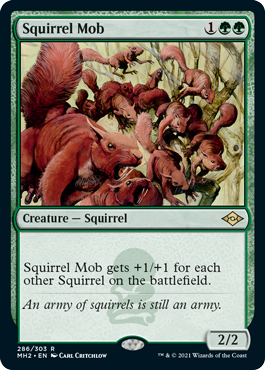
Yes, it's Squirrel Mob, a card I designed many years ago in Odyssey (on that set, I oversaw creature types
. . . oh, look—a whole lot of Squirrels).
Now it's time to see some new Squirrel cards. First up, an uncommon that will help you fill your side of the battlefield with Squirrels.
Click here to see Squirrel Sanctuary

Next, is a black-green hybrid card that will help your Squirrel deck draw cards.
Click here to see Ravenous Squirrel
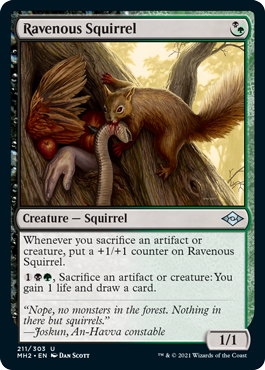
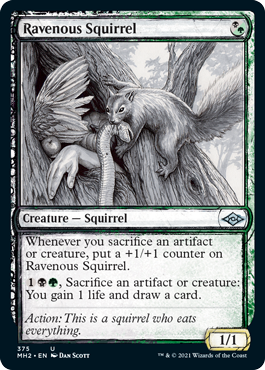
Deranged Hermit was the first Squirrel lord, but there have since been a few more. Let's meet a new one from Modern Horizons 2, an uncommon no less, so you can draft around it.
Click here to see Squirrel Sovereign

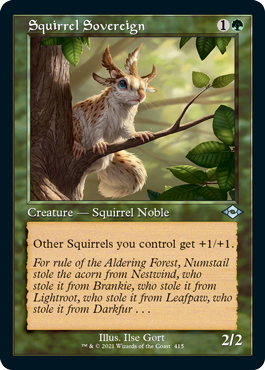
Finally, the last preview card I have to show you is for all the Squirrel-loving Commander players out there. Yes, finally, a black-border black-green Squirrel commander.
Click here to meet Chatterfang, Squirrel General
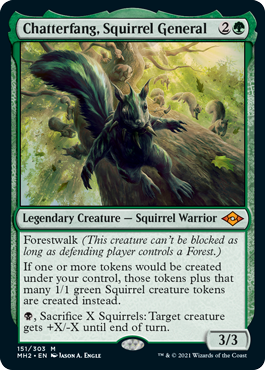
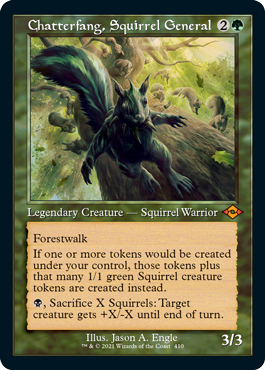
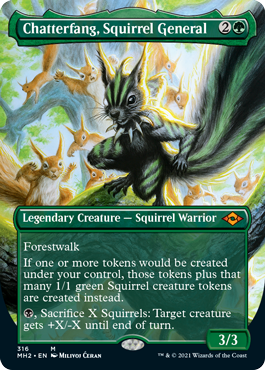
I hope all of you Squirrel fans out there are as excited as I am. I also want to note that there are a whole bunch more Squirrel cards that I'm not previewing. Squirrels have firmly and unequivocally made their way to black border.
Aw, Nuts!
And with that splendiferous Squirrel previewing, we are out of time for today. As always, I'm eager to hear your feedback on today's column, on Modern Horizons 2, or on Squirrels. You can email me or contact me through any of my social media accounts (Twitter, Tumblr, Instagram, and TikTok).
Join me next week as I walk through Modern Horizons 2's set design and show off some non-Squirrel preview cards (using a different theme I'm also quite excited about).
Until then, may something you do pay off 24 years later.
#835: Unsanctioned with Matt Tabak
#835: Unsanctioned with Matt Tabak
38:56
I sit down with Magic editor Matt Tabak to talk about the creation of Unsanctioned, the Un- box set.
#836: Unglued, Part 2
#836: Unglued, Part 2
32:38
This podcast is part two of a three-part series where I discuss the design of every card in Unglued.
- Episode 834 Unglued, Part 1
- Episode 833 Worldwake with Ken Nagle
- Episode 832 More Codenames

